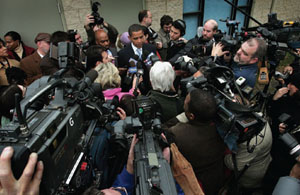Warning Signs: Tips for Spotting Phony Facts and Fake News
In an era when websites and online newspapers earn income by the number of clicks they receive, writing the most inflammatory version of events is a sure way to attract readers. In 2017, the author of the “Annoyed Librarian” series in Library Journal examined and debunked the following fake news stories:
-
California School Defunded for Having Too Many White Students
-
Rollins College Suspends Student After He Challenged Radical Muslim Hate Speech
-
Libraries Become New Domestic Terrorism Target in Trump Wave of Hate Crimes
All are examples of “fake news” that contain an element of truth exaggerated and rewritten to attract and inflame readers. They take as evidence the claims made by people involved in the story, without investigating the claims themselves. Or they connect two events which may or may not have any real connection to each other. Or they characterize troubling but isolated incidents as symptoms of larger trends.
|
This video busts some common research myths and provides tips on how you can use Digital Literacy to conduct better research.
Rosen Digital
|
Exaggeration and innuendo are also things to look out for. Another word for exaggeration is “hyperbole,” or “hype.” Some news organizations hype stories and facts to make them seem more important than they really are. “Innuendo” is a word that means saying something without really putting it into words, or saying something indirectly. We see examples in news stories that ask questions without answering them—for instance, an article that shows a picture of a man’s face with the headline: “Is This Man a Murderer?” If it has been proved that the man is a murderer, the headline should say so. Otherwise, it shouldn’t be implied.
Mistakes in writing and punctuation can be another sign of source trouble. Everybody makes mistakes, but if a source is careless with spelling and grammar, we have to wonder how careful the source is with facts.
Emotional and inflammatory language is a strong indicator of bias. Racial slurs and hate speech are extreme examples of this. Other kinds of emotional language appeal to our pity, envy, pride, or other feelings, rather than our thinking. Emotional language can be deceiving. For instance, a charity that helps sick children might use very emotional language to appeal for donations. Although the organization might seem credible and the cause worthy (who wouldn’t want to help sick kids?), it’s best to take a closer look. Does the organization say that it has actually helped any children? Does the organization have any proof of its success?
A Simple Test
 |
|
Professional journalists are taught to avoid personal bias, but everyone has a unique viewpoint. Newspeople often report things
in different ways because they have different ideas of what’s important.View Larger Image
|
|
Scott Olson/Getty Images
|
Sometimes it’s possible to spot phony facts just by looking at them. When there is doubt about a source’s accuracy, conducting this simple two-part test may help:
-
Search online for the source’s name. What do others say about the source? What are the source’s qualifications? What does the source do for a living? Does the source have anything to gain by slanting the information?
-
Find material similar to that of the source by doing a search using key phrases from the source’s material. Does this material agree with the source’s material? Has anybody else used the source’s material?
If the source fails either part of the test, don’t trust it. Dump the source and move on. Check the comparison material from the second step for possible new sources.
Recognizing Bias
“Bias” is a term that describes a slanted or prejudiced point of view. Everyone has a point of view, and everyone presents information from that viewpoint. No one, not even the best source, can be entirely free of bias. We all have our points of view and our likes and dislikes. Professional reporters are taught to watch out for their personal biases and keep them out of their reporting as much as possible.
 |
|
On their Comedy Central shows, comedians Stephen Colbert (left) and Jon Stewart (right) got many of their laughs by mocking
what they saw as bias in reporting by the major news organizations.View Larger Image
|
|
Brad Barket/Getty Images for Comedy Central
|
However, some bias is intentional. Some sources want others to see things as they do and therefore intentionally leave out important facts. They may also treat trivial facts as being important. Biased sources usually don’t reveal why they want to slant the information.
When we suspect bias, we should ask ourselves these questions:
-
Is my source emphasizing some facts and downplaying others?
-
If so, why?
-
How could the source benefit by slanting the information?
The best way to detect bias is to check the source against other sources. In fact, it’s often the only way. That’s why researchers try to have at least two sources for every piece of information. When it comes to sources, more is always better.
Using multiple sources to test for credibility is a two-step process. The first step is to find out what others say about the source. Are they a Nobel Prize scholar? A veteran reporter? A notorious practical joker? If the source is credible, proceed to the second step, which is to find out if other sources agree with the information. Do other sources say something slightly different? Do they say something entirely different? For most topics, there are plenty of sources available on the Internet or in the library. With practice, bias becomes easier to spot.
Serious Information?
Sometimes the look of a web page provides clues about the quality of information that it has. Weird wallpaper? Lots of different fonts in different colors? Cute icons? Quirky little apps? These can be warning signs. If a site doesn’t have a serious design, it might be good to consider whether or not it contains serious information.
There’s nothing wrong with interesting graphic elements. And facts don’t have to look dull. However, it’s more important that the page be functional. Does the site have useful information? Do all the site’s links work? Do the links connect to credible sources? Do the links connect to information about the site?
Spotting Deepfakes
A deepfake is a video created by artificial intelligence (AI) and appearing to be something it is not, whether that’s a political candidate saying something politically damaging, a celebrity engaging in pornographic behavior, or a financial offer meant to steal your money. Deepfakes are increasingly sophisticated, able to trick even the most savvy and suspicious digital natives, but there are some things you can look out for:
-
Do a reverse search on the image or video to find out who originally created it. If they have a strong reason to create the image, such as persuading you to think or act in a certain way, they have more reason to create a fake.
-
See where else it has been displayed. If none of the other places are credible sources, it may be a fake.
-
If the image is of a human, pay attention to details in the face. Does the facial hair look real and consistent? Is the skin too smooth or too wrinkled? Are the skin tone and age on the face similar to the skin on the rest of the body?
-
Pay attention to the lighting. Do the shadows seem realistic and consistent with each other? Is there a natural glare or distortion in the eyes from someone wearing glasses?
-
Pay attention to the lips. Many deepfake videos use lip syncing. Do the lips move naturally? Do they stop and start at the same rate as the words being spoken?
-
Does the person blink naturally? Do they turn their head in ways that look natural?
-
Most importantly, don’t believe everything you see.




